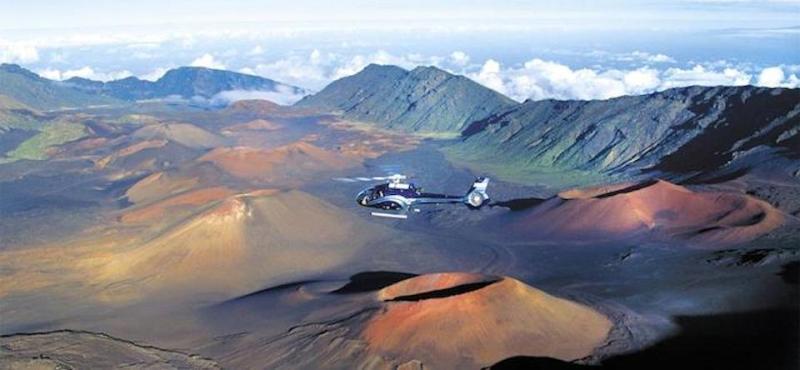
A federal appeals court has ordered the National Park Service and Federal Aviation Administration to finalize air tour management plans/NPS
A federal court, noting that National Park Service and Federal Aviation Administration have failed for 19 years to develop air tour management plans for national parks, on Friday ordered the agencies to get the work done.
“For almost 20 years, the FAA and the NPS have allowed an airborne reign of terror to go unmitigated over park skies,” said Public Employees for Environmental Responsibility General Counsel Paula Dinerstein, who argued the case before the court. “PEER will work with affected communities and parks to, at long last, develop responsible air tour management plans.”
Last year PEER and Hawaii Island Coalition Malama Pono sued the federal agencies, saying they had vowed to take action but were "offering little relief from noisy air tours droning over national parks."
It was 20 years ago that the National Park Air Tour Management Act of 2000 was implemented and required the FAA, in coordination with the NPS, to set limits on overflight numbers, timing, and routes to protect park resources and the visitor experience. FAA and NPS officials last year said they would meet on August 9 to begin work to establish mandatory air tour management plans or voluntary agreements for seven units of the National Park System. What came out of those meetings was unsatisfactory to PEER and HICoP.
The lawsuit asked the court to order mandatory deadlines for adoption of air tour limits covering seven parks that account for more than half of the overflights: Hawaii Volcanoes, Haleakalā, Glacier, Bryce Canyon, and Great Smoky Mountains National Parks, Lake Mead National Recreation Area, and Muir Woods National Monument.
On Friday, the U.S. District Court of Appeals in the District of Columbia agreed with PEER and the Coalition that no progress had been made on developing plans for 23 parks.
"Although applications have been pending at twenty-five parks for nearly two decades, the agencies have fulfilled their statutory mandate at only two," wrote Judge Thomas Griffith for the unanimous court. "Petitioners seek a writ of mandamus to compel the agencies to regulate air tours at seven parks where they have injured members. Because the agencies have failed to timely do so, we grant the petition."
Parks affected by the court's ruling are:
- Hawaii Volcanoes National Park
- Haleakalā National Park
- Glacier National Park
- Bryce Canyon National Park
- Great Smoky Mountains National Park
- Lake Mead National Recreation Area
- Muir Woods National Monument
- National Parks of New York Harbor
- Glen Canyon National Recreation Area
- Mount Rushmore National Memorial
- Golden Gate National Recreation Area
- Badlands National Park
- Rainbow Bridge National Monument
- San Francisco Maritime National Historical Park
- Arches National Park
- Point Reyes National Seashore
- Canyonlands National Park
- Bandelier National Monument
- Olympic National Park
- Natural Bridges National Monument
- Everglades National Park
- Canyon de Chelly National Monument
- Mount Rainier National Park
When the lawsuit was filed, PEER claimed deficiencies in the FAA’s work included plans being "generally reliant upon the consent of air tour operators"; "no guarantee of any flight reductions. The FAA has already granted interim air approvals for far more than the actual number of tours;" and no firm deadlines for plans to be implemented.
“If there is no credible threat of a mandatory limit, tour operators have zero incentive to voluntarily impose one,” Dinerstein said back in October. “The government’s latest filing only reinforces the case for judicial intervention since FAA and NPS appear institutionally incapable of constraining commercial aviation, no matter how damaging to parks.”
In the court's ruling, Griffith pointed out that Congress in 2012 amended the Air Tour Management Act to allow for "voluntary agreements" with air tour operators in parks where there were 50 or fewer air tours per year. In 2015 a plan was approved for Big Cypress National Preserve, and in 2016 another for Biscayne National Park, the ruling noted.
"But the statutory fix was no magic bullet," the judge wrote. "Getting air tour operators to sign on to voluntary agreements without the credible threat of a management plan proved difficult. Each operator gains a competitive advantage by hanging on to their (largely unregulated) interim authority while their rivals voluntarily accept restrictions."
While the attorneys for the Department of Justice and FAA argued that “there is no guarantee that air tour impacts would be reduced with the implementation of plans or voluntary agreements," Griffith wrote that the petitioners did not have to demonstrate that relief would be achieved through management plans. But even so, he wrote that "(M)anagement plans may prohibit air tours altogether or establish certain conditions, including noise mitigation, and plans 'shall include incentives . . . for the adoption of quiet aircraft technology.' Plans and agreements are thus substantially likely to mitigate the noise impact of air tours."
In conclusion, the court ordered "the agencies to propose a schedule for bringing all parks into compliance. In crafting this schedule, the agencies should bear in mind that Congress expected them to complete the task in two years."
"Left to their own devices, the agencies have failed to comply with their statutory mandate for the past nineteen years," Griffith wrote. "Accordingly, we grant the petition for a writ of mandamus and order the agencies to produce a schedule within 120 days of the issuance of this opinion for bringing all 23 parks into compliance."

 Support Essential Coverage of Essential Places
Support Essential Coverage of Essential Places






